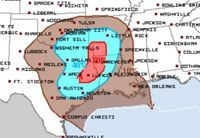East Texas and much of the broader region were treated to a rare and much-needed soaking before sunrise on October 25, 2025, as storms swept across the Pineywoods, Central Texas, and even down to Houston. According to Townsquare Media, rainfall totals of half an inch to an inch and a half were common across East Texas, with heavier pockets in Anderson, northern Cherokee, and Smith Counties. But as welcome as that rain was for the parched ground, forecasters warned that the wet weather was far from over.
By Saturday morning, the National Weather Service (NWS) was sounding the alarm for another round of widespread showers to persist throughout the day in Deep East Texas, with some regions expected to pick up another half inch of rain. The real drama, though, was forecast to unfold as night fell. Meteorologists at the Storm Prediction Center pegged the chance of a line of thunderstorms rolling from Lufkin to Shreveport between 7 p.m. and 11 p.m. at about 70 percent—though they cautioned that much depended on how the afternoon atmosphere shaped up. The overnight rain had tamped down some of the instability needed for severe storms, but computer models still showed enough energy for strong storms to develop.
“There is a slight risk of severe weather across south-central Texas, southeast Texas, and portions of the Pineywoods,” Townsquare Media reported, emphasizing that damaging straight-line winds were the main threat. But there was also a real possibility for tornadoes, particularly along the upper Texas coast, including the Houston metro area. That warning would soon prove prescient.
In Houston, the impact of the storms was immediate and dramatic. As reported by Houston Public Media, more than 100,000 homes and businesses lost power early Saturday morning as strong overnight thunderstorms battered the region. CenterPoint Energy, the area’s main electricity provider, said outages peaked at over 140,000 customers around 7:30 a.m. but dropped to fewer than 70,000 by 9 a.m. after the company deployed 1,300 frontline workers in a rapid response. The Houston area was placed under a flood watch until 5 a.m. Sunday, with NWS meteorologists predicting 2 to 4 inches of rain for most of the region and some locations possibly receiving up to 6 inches.
The NWS Weather Prediction Center had issued a particularly stark advisory overnight, warning that some parts of Southeast Texas could see rainfall rates exceeding 2 inches per hour. Severe thunderstorm and tornado warnings lit up local weather alerts in the early morning hours, and rain flooded a stretch of Interstate 45 north of downtown Houston, causing headaches for Saturday travelers. Fortunately, showers in the Houston area were expected to taper off by Sunday afternoon.
Central Texas, too, found itself in the crosshairs of the storm system. The Dallas Morning News reported that storms were rolling through several parts of North Texas on Saturday evening, with Central Texas bracing for strong and severe storms that could bring hail and damaging winds. North Texas, including the Dallas-Fort Worth metroplex, faced a 30 percent chance of showers and thunderstorms after 1 p.m. on Saturday. The weather service cautioned that heavy rainfall could lead to localized flooding, and a cluster of storms moving into Johnson County was tracked northeast, potentially impacting central and eastern portions of Dallas-Fort Worth during the afternoon.
Lightning strikes were spotted on radar as far north as Burleson, and a large swath of north-central, northeast, and south-central Texas was placed under a flood watch until 10 p.m. on Saturday. The storms also left a trail of power outages in their wake. By Saturday morning, roughly 20,000 people in North Texas were without electricity, with the majority—18,000—located in Tarrant County and another 2,800 in Dallas County, according to Oncor’s outage map.
The Dallas-Fort Worth International Airport reported about 3 inches of rainfall since Thursday, while Fort Worth itself saw an even more impressive 4.6 inches, the NWS confirmed. Severe thunderstorm warnings were issued Friday night, and a tornado warning was sounded in Parker County. The NWS said it was investigating reports of a possible tornado in Fort Worth after wind damage was reported, but as of Saturday, it remained unclear whether a tornado had actually touched down. The weather service took to social media, asking residents to send in damage reports to help piece together what had transpired.
For those planning their weekend, the forecast offered some hope of improvement. According to KXAS-TV (NBC5), Saturday would remain mostly cloudy, with scattered afternoon showers and thunderstorms and a high near 75°F. Showers were expected to clear gradually overnight, with a low of 60°F. Sunday promised a mix of sun and clouds and a mild high of 76°F, while Monday would be mostly sunny and warm, reaching 80°F. But by Tuesday, cooler air would filter in, with highs dropping to 70°F and lows in the upper 50s. The cool-down would continue through the week, with highs in the mid-60s and lows dipping into the upper 40s by Thursday and Friday.
East Texas, meanwhile, faced a similar pattern. After the passage of the storm system Saturday night, meteorologists forecasted a reinforcing blast of cooler air on Tuesday, October 28, with highs only in the 60s and lows in the 40s by mid-week, Townsquare Media noted. For residents weary of the heat and humidity, that forecast no doubt sounded like a welcome change, even if it came at the cost of a stormy weekend.
Despite the disruption, the rainfall brought at least one silver lining for the region’s drought-stricken landscapes. After weeks of dry weather, the blanket of precipitation helped replenish soil moisture and refill reservoirs in many communities. Still, for thousands left in the dark and those facing flooded roadways, the storms were a vivid reminder of how quickly Texas weather can turn from blessing to challenge.
As the skies clear and cooler air settles in, East Texas, Houston, and North Texas residents will be assessing the aftermath—repairing damage, restoring power, and, perhaps, breathing a sigh of relief that the worst of the storms have passed for now. The forecast, at least, suggests a calmer and cooler week ahead.

